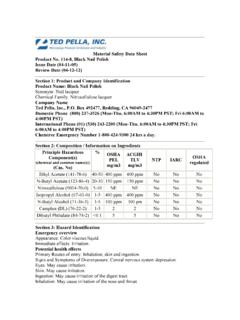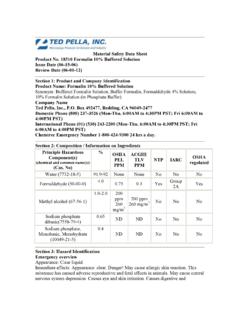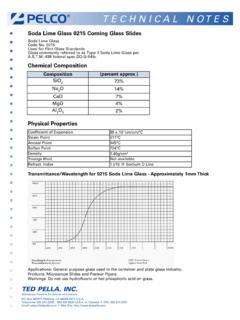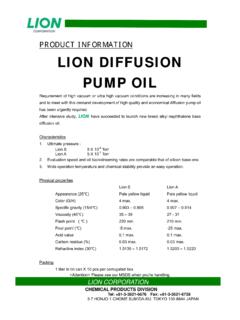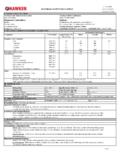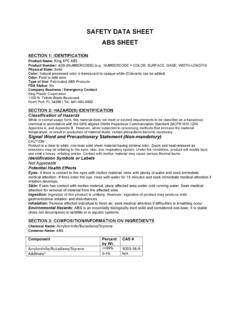Transcription of Material Safety Data Sheet Domestic Phone (800) …
1 Material Safety data Sheet Product No. 18612 Acetonitrile Issue Date (06-26-96) Review Date (06-01-12) Section 1: Product and Company Identification Product Name: Acetonitrile Synonym: Cyanomethane, ethanenitrile, ethyl nitrile, methanecarbonitrile, methyl cyanide. Company Name Ted Pella, Inc., Box 492477, Redding, CA 96049-2477 Domestic Phone (800) 237-3526 (Mon-Thu. 6:00AM to 4:30PM PST; Fri 6:00AM to 4:00PM PST) International Phone (01) (530) 243-2200 (Mon-Thu. 6:00AM to 4:30PM PST; Fri 6:00AM to 4:00PM PST) Chemtrec Emergency Number 1-800-424-9300 24 hrs a day. Section 2: Composition / Information on Ingredients Principle Hazardous Component(s) (chemical and common name(s)) (Cas.)
2 No) % OSHA PEL mg/m3 ACGIH TLV mg/m3 NTP IARC OSHA regulated Acetonitrile (75-05-8) 100 70 67 ND ND ND Section 3: Hazard Identification Emergency overview Appearance: Colorless liquid with a sweet ethereal odor. Immediate effects: Irritation of the nose and throat with sneezing, sore throat or runny nose. Potential health effects Primary Routes of entry: Inhalation, skin contact, eye contact. Signs and Symptoms of Overexposure: Chest tightness or main, flushing of the face, central nervous system depression with dizziness, confusion, uncoordinated, drowsiness or unconsciousness; convulsions; impaired blood clotting with increased tendency toward bruising and bleeding; low blood pressure; increased heart rate; abnormal kidney function with altered urinalysis; and abnormal liver function with altered enzyme levels I blood.
3 The on-set of symptoms may be delayed. Gross overexposure may cause fatality. Eyes: Eye irritation with tearing, pain or blurred vision. Skin: Slight irritation with itching, redness or swelling. Ingestion: Nausea or vomiting. Inhalation: Irritation of the nose and throat with sneezing, sore throat or runny nose. Chronic Exposure: ND Chemical Listed As Carcinogen Or Potential Carcinogen: This Material contains 5 ppm Acrylonitrile (107-13-1) which is known in the state of California to cause cancer See Toxicological Information (Section11) Potential environmental effects See Ecological Information (Section 12) Section 4: First Aid Measures If accidental overexposure is suspected Eye(s) Contact: In case of contact, immediately flush eyes with plenty of water for at least 15 minutes.
4 Call a physician. Skin Contact: In case of contact, immediately flush with plenty of water for at least 15 minutes while removing contaminated clothing and shoes. Call a physician. To prevent cross-contamination, properly dispose of contaminated clothing and shoes with minimal handling. Avoid contact. Inhalation: If inhaled, immediately remove to fresh air. If not breathing, give artificial respiration. If breathing is difficult, give oxygen. Call a physician. Ingestion: If swallowed, immediately give 2 glasses of water and induce vomiting. DO NOT GIVE Syrup of Ipecac. Never give anything by mouth to an unconscious person. Call a physician. Note to physician Treatment: Although the metabolic fate of this compound is not completely known, some nitriles are partially metabolized to cyanide.
5 Symptoms may be delayed. If overexposed, treatment for cyanides may be indicated. Following exposure, the patient should be observed for 24-48 hours or more for symptoms of cyanide intoxication. Treatment for cyanide intoxication: 1. If conscious but symptoms (nausea, difficult breathing, dizziness, etc.) are evident, give oxygen. 2. If consciousness is impaired (non- responsiveness, slurred speech, confusion, drowsiness) or the patient is unconscious but breathing, give oxygen and amyl nitrite by means of a respirator. To give amyl nitrite, break an ampoule in a gauze pad and insert into lip of mask for 15 seconds, then take away for 15 seconds. Repeat 5-6 times. If necessary, use a fresh ampoule every 3 minutes until the patient regains consciousness (usually 1-4 ampoules).
6 Administer oxygen continuously. Guard against the ampoule entering the patient s mouth. 3. If not breathing, give oxygen and amyl nitrite immediately by means of a positive pressure respirator (artificial respiration). See 2 above, and continue to give oxygen simultaneously to aid recovery. If massive exposure occurred, consider keeping the first one or two ampoules in the lip of the mask continuously. Guard against the ampoule entering the patient s mouth. Medical treatment: Do not over-react. Although prompt action is essential when symptoms of poisoning occur, a lucid conscious person who can communicate may not have significant cyanide poisoning and medical treatment may not be necessary. "Treat what you see" is a good rule of thumb. Mildly symptomatic patients who remain alert may be managed by supportive care only.
7 First aid of oxygen and amyl nitrate may be the only treatment needed. However, in severe intoxication, medical treatment of sodium nitrite and sodium thiosulfate may be needed. Medical treatment procedure: Intravenous antidote: Sodium nitrite: Adult 10 ml of 3% solution (300mg) Draw solution from ampoule and inject slowly over 4-5 minutes (2 to ). As soon as practical, monitor blood pressure and continue checking pulse. Slow the rate of injection if hypotension (low blood pressure) occurs. 1. Sodium thiosulfate: Adult 50 ml of 25% solution ( grams). Follow sodium nitrite with sodium thiosulfate injected at a rate of ml/minute (10-20 minutes). The total time for injection of these initial doses of both components at the recommended rates is lengthy, approximately 20-25 minutes.
8 Consider the body weight and condition of the patient when treating with sodium nitrite. Both amyl nitrite and sodium nitrite produce methemoglobin, which reduces the oxygen carrying capacity of the blood. Methemoglobinemia is potentially harmful when hemoglobin levels exceed 20-30%. If symptoms persist or recur after the initial treatment, repeat the antidote at one half the original dose and one hour after the original administration. Monitor methemoglobin levels when practical in every patient treated with the intravenous antidote. Avoid over-treatment: The above sodium nitrite injection is about one-third the lethal dose. Care should be taken to avoid excessive use. It is NOT essential that full quantities of antidote be given just because treatment was started.
9 Should injection be stopped for any reason, keep track of the amount administered in case treatment needs to be restarted. Medical Conditions generally Aggravated by Exposure: Increased susceptibility to the effects of Acetonitrile may be observed in persons with the pre-existing disease of the central nervous system, liver, kidneys, lungs, and cardiovascular system. Section 5: Fire Fighting Measures Flash Point: 6 C /43 F, (COC) IMDG Reference Flash Point: 2 C Flammable Limits: LEL: ; UEL16% Auto-ignition point: 524 C / 975 F Fire Extinguishing Media: Water spray, foam, dry chemical. Water may be ineffective. If leak or spill has not ignited, use water spray to disperse vapors and protect men attempting to stop the leak. Water spray may be used to flush spills away from exposures and to dilute spills to non-flammable mixtures.
10 Special Fire Fighting Procedures: Evacuate personnel to a safe area. Wear self-contained breathing apparatus. Wear full protective equipment. Cool tank/container with water spray. Keep personnel removed and upwind of fire Unusual Fire and Explosion Hazards: Flammable liquid. Vapor forms explosive mixture with air. Vapors or gases may travel considerable distances to ignition source and flash back. Hazardous combustion products: Hydrogen cyanide and carbon monoxide. DOT Class: Flammable Liquid. Section 6: Accidental Release Measures Steps to be Taken in Case Material is Released or Spilled: Review fire fighting measures and handling (personnel) section before proceeding with clean up. Use appropriate personal protection equipment during clean up. Evacuate personnel, thoroughly ventilate area, and use self-contained breathing apparatus.
